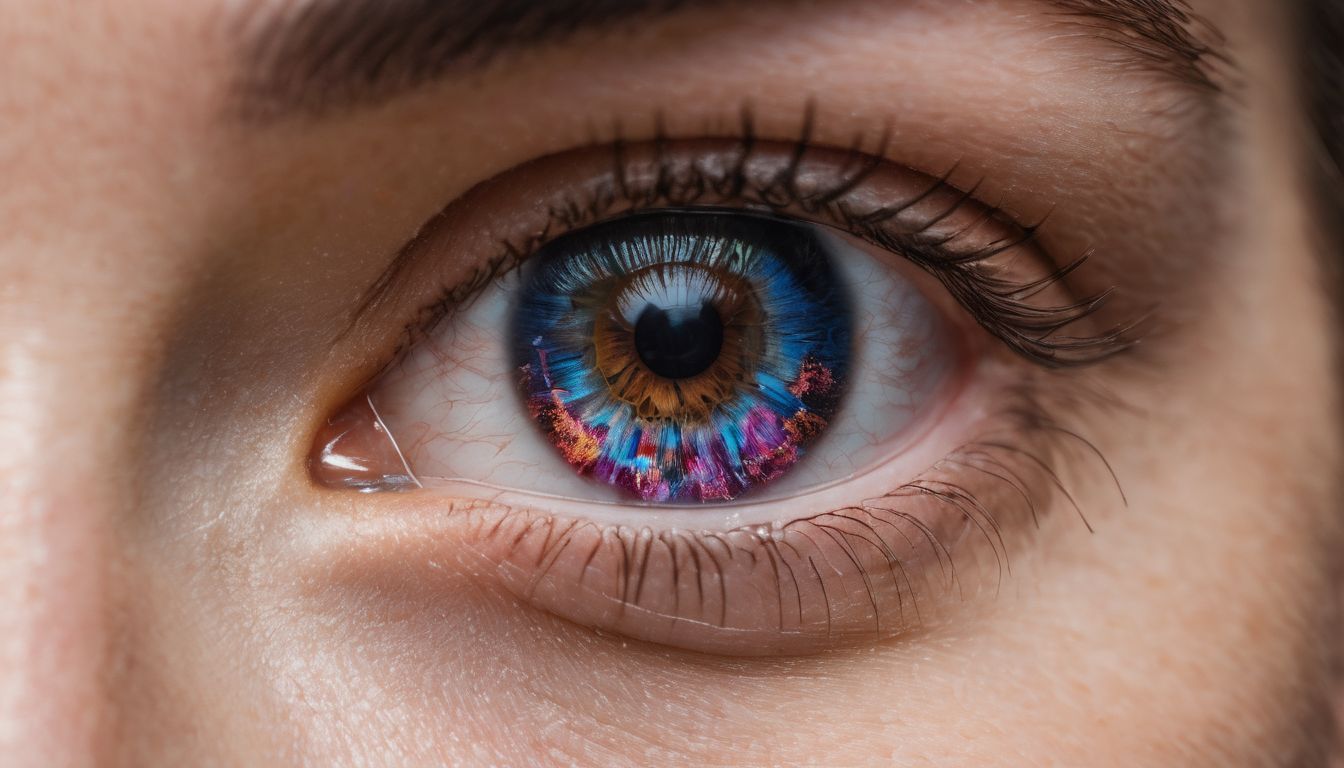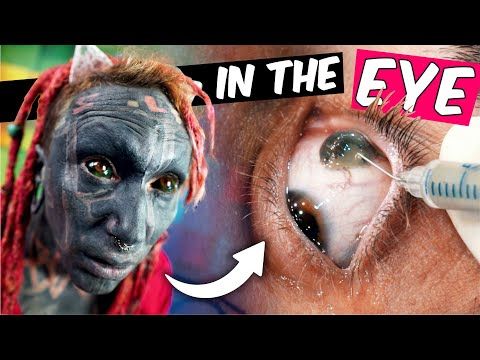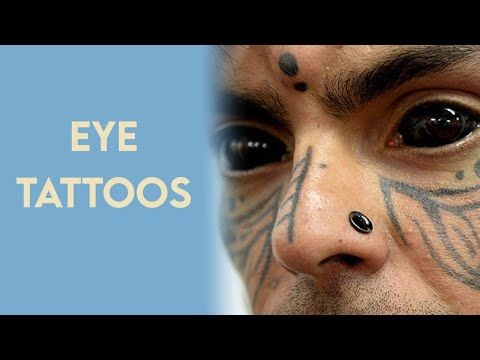The Dangers of Eye Ball Tattoos: What You Need to Know
Thinking about getting your eyes tattooed? Eyeball tattoos can lead to serious risks like infection or even blindness. Our article breaks down what you need to know before considering such a procedure, from the dangers to legal aspects.
Keep reading; your vision may depend on it!
Key Takeaways
- Eyeball tattoos involve injecting ink into the white part of the eye, which can cause severe risks like infection, vision loss, and blindness.
- Professional tattoo artists may refuse to perform eyeball tattoos due to the high risk of complications such as retinal detachment or corneal damage.
- In New South Wales and other regions, laws may prohibit scleral tattooing because of its potential to cause serious health issues, emphasizing the need for legal awareness.
- Incidents of eye pain, vision impairment, and even partial blindness in well – documented cases highlight why it’s critical to understand the dangers before considering this procedure.
- Alternatives like temporary skin tattoos, body piercings, henna artistry, or cosmetic contact lenses offer safer ways for personal expression without risking eye health.
What are Eye Ball Tattoos?
Eye ball tattoos, also known as scleral tattooing or eye modification, involve injecting ink into the whites of the eyes to permanently change their color. This procedure carries serious health risks and complications, making it a controversial practice in the tattoo community.
Procedure
Eyeball tattoos are a high-risk procedure that alters the color of the sclera, or white part, of the eye. Tattoo artists perform this process by injecting ink under the surface of the conjunctiva, leading to permanent eye color change.
- First, a professional tattoo artist prepares the area around the eyes and selects appropriate tools for ink injection.
- The recipient must stay very still as any movement can lead to severe complications.
- Using a needle, the artist injects ink directly into the white part of the eye, covering it in small segments to ensure even distribution.
- Throughout this procedure, there is a significant risk of piercing sensitive tissues which can cause infection or more serious damage.
- Injections are repeated until the desired hue covers most of the sclera without spilling into other parts of the eye.
- This process often causes immediate inflammation and discomfort for days or weeks after completion.
- Afterward, recipients require careful monitoring for symptoms such as blurred vision or persistent pain which indicate possible infection or ocular damage.
- Artists should use clean needles at all times to reduce risk; however, if proper sterile techniques are not followed, there’s an increased chance of introducing bacteria that can lead to severe infections.
- Due to potential health risks like retinal detachment and blindness associated with scleral tattooing, individuals need thorough consultations about these dangers before undergoing this form of eye modification.
Risks
Eyeball tattoos pose significant risks to eye health.
- Infection can occur if the tattoo artist does not use clean needles, leading to potential vision damage.
- The ink used in eyeball tattoos can also cause infections, resulting in permanent eye complications.
- Scleral tattooing carries a high risk of infection due to its proximity to sensitive tissues inside the eyeball.
- Long – term risks are still unknown, with potential effects on vision and overall eye health.
- Complications such as retinal detachment or permanent damage to cells inside the eye can lead to vision loss and blindness.
- Severe risks include constant discomfort, blurred vision, glaucoma, cataracts, and corneal injuries.
- Eyeball tattoos are considered a dangerous fad that poses serious threats to eye health and should be approached with caution.
- Without proper care and safe practices during the procedure, serious complications such as blindness may occur.
- Tattoo removal procedures for eyeball tattoos also carry potential risks and should be carefully considered.
- Proper awareness of the dangers related to eyeball tattoos is crucial for promoting eye safety and preventing severe complications.
History and practice
Eyeball tattoos, or sclera tattoos, have been around since the late 2000s and were first performed by Luna Cobra in 2007. The procedure involves injecting ink into the eye’s white outer layer using a needle.
Originally intended for individuals with corneal damage, it has gained popularity as a form of body modification despite significant health risks. Due to growing concerns over safety and potential complications, many professional tattoo artists refuse to perform this risky procedure.
Currently, there is no standardized training or regulation for eyeball tattooing among practitioners. This lack of oversight increases the likelihood of improper procedures leading to severe complications such as infection and permanent vision impairment.
Legislation Surrounding Eye Ball Tattoos
Laws in NSW and other regions may prohibit or regulate the practice of eyeball tattoos. It is important to understand the legal implications and seek out relevant resources before undergoing such a procedure.
Laws in NSW
Laws in NSW aim to regulate eyeball tattooing and prevent associated health risks.
- The Public Health (Tattooing and Body Piercing) Regulation 2018 in New South Wales specifically prohibits the tattooing of the eyeball. This regulation emphasizes the serious health risks of eye tattooing.
- Under this law, the procedure is considered a prohibited practice due to its potential to cause severe eye damage, infections, and vision impairment.
- Practicing eyeball tattoos is an offense that can lead to penalties for both the person performing the tattoo and the individual requesting it.
- The laws also serve to protect individuals from unscrupulous tattoo artists who may attempt to perform this dangerous procedure.
- These regulations are based on extensive research indicating the substantial risks associated with eyeball tattoos, as seen in documented cases of severe complications and permanent damage.
Translations and related resources
After understanding the laws surrounding eyeball tattoos in NSW, it’s crucial to provide accessible translations and related resources for individuals considering or affected by this trend.
Informative materials about eye health risks, safety concerns, and available support systems are essential. Providing translated resources can help reach diverse communities and ensure that everyone comprehends the dangers associated with eye tattoos.
It is imperative to make information easily accessible in different languages to raise awareness about the severe complications of sclera tattooing.
Individuals seeking information on eye tattoo risks should have access to reliable translated resources. By expanding educational materials into multiple languages, we can effectively communicate the potential dangers of eyeball tattoos across various communities.
The Dangers of Eye Ball Tattoos
Eye ball tattoos pose significant health risks, including the potential for serious eye infections and long-term complications. Several famous cases have highlighted the dangers of this procedure, underscoring the need for caution and awareness.
Health risks
Eyeball tattoos pose significant health risks, including the potential for infection and vision impairment. The injection of ink into the eye can lead to complications such as constant discomfort, blurred vision, corneal injury, glaucoma, cataracts, and even blindness.
Furthermore, there is a risk of retinal detachment and permanent damage to cells inside the eye that could result in loss of sight. These serious health hazards make it crucial for individuals to carefully consider the potential consequences before pursuing eyeball tattoos.
The long-term effects of scleral tattooing are largely unknown; however, current evidence suggests that risks extend beyond simple irritation or infection. It’s important to recognize that eyeball tattoos are not just a form of self-expression but also carry substantial dangers that can impact overall eye health.
Complications
Eyeball tattoos can lead to various complications that pose serious risks to eye health. Risks of eyeball tattoos range from mild eye irritation to severe consequences such as blindness, constant discomfort, blurred vision, and injury to the cornea.
Infections caused by unclean needles or the ink itself can result in serious complications. Additionally, scleral tattooing carries a high risk of infection due to its proximity to sensitive tissues inside the eyeball.
Permanent damage to cells within the eye that allow us to see, retinal detachment, and glaucoma are also potential complications associated with eyeball tattoos.
The dangers of eyeball tattoos include potential blindness and other significant eye complications that can arise from this dangerous fad. Long-term risks remain largely unknown but may include permanent vision impairment or loss.
Famous cases of complications
Complications from eyeball tattoos have led to severe consequences in several well-documented cases. These incidents serve as stark warnings of the potential dangers associated with this risky trend. Here are some notable instances that highlight the serious risks involved in eyeball tattooing:
- A famous case involved a woman who experienced severe eye pain and vision impairment after getting an eyeball tattoo. She later developed complications leading to permanent vision loss.
- In another high – profile case, a man who underwent scleral tattooing reported enduring excruciating pain and eventually suffered irreversible damage to his cornea, resulting in partial blindness.
- Additionally, a renowned tattoo artist had to undergo emergency eye surgery due to complications stemming from an eyeball tattoo procedure, emphasizing the occupational hazards faced by individuals performing these risky practices.
- Furthermore, a documented incident detailed how an individual contracted a serious eye infection following an eyeball tattoo, ultimately necessitating multiple surgeries to prevent further deterioration of their eyesight.
- Lastly, a widely publicized case revealed how an individual experienced persistent discomfort and obscured vision after undergoing sclera tattooing, prompting concerns about the long-term impact on their eye health.
Talking to Customers About Eye Ball Tattoos
Emphasize the importance of knowing the risks and promoting safe tattoo practices to customers considering eye ball tattoos. Encourage caution and informed decision-making when it comes to permanent makeup procedures.
Read more about the dangers of eye ball tattoos in our blog post.
Knowing the risks
Eyeball tattoos carry significant risks, from potential infections to permanent vision loss. The dangers of eye ink injections include the risk of constant discomfort, blurred vision, glaucoma, and injury to the cornea.
Long-term effects such as cataracts and blindness can result from scleral ink injection. Additionally, serious complications like retinal detachment and permanent damage to eye cells are possible outcomes.
The health risks associated with eyeball tattoos are substantial and should not be overlooked. Infections can occur due to unclean needles or the ink itself used during the procedure.
Promoting safe tattoo practices
When promoting safe tattoo practices, it is crucial to educate customers about the potential risks of eyeball tattoos. Providing clear information about the health risks and complications associated with sclera tattooing can help individuals make informed decisions.
Tattoo artists should prioritize safety by using sterile equipment and ensuring proper hygiene during the procedure, minimizing the risk of infection and other serious eye complications.
Encouraging a cautious approach to eye tattoos can prevent potential blindness and protect overall eye health. Emphasizing the importance of seeking professional advice before undergoing such procedures reinforces safe tattoo practices within the community.
Conclusion and Resources
Encouraging caution when considering eye ball tattoos and providing resources for more information on the risks and alternatives. Read on to learn more about the dangers associated with this trend.
Encouraging caution
Eyeball tattoos come with serious risks that can lead to irreversible damage and vision loss. Potential complications include infection, constant discomfort, blurred vision, glaucoma, cataracts, injury to the cornea, and even blindness.
It is crucial for individuals considering eyeball tattoos to understand the gravity of these risks and make an informed decision about whether the potential consequences are worth it.
Ensuring caution when discussing this extreme form of body modification is essential in promoting eye health and preventing unnecessary harm.
Artists offering eyeball tattooing should prioritize educating their clients about the significant health risks involved. Emphasizing safety precautions is vital to protect customers from potentially life-altering consequences associated with this trend.
Where to find more information
To find more information on the dangers of eye ball tattoos, consider consulting reputable sources such as ophthalmologists, optometrists, and eye care professionals. Additionally, health organizations and medical websites can provide valuable insights into the risks associated with eyeball tattoos.
It’s important to seek information from reliable resources that offer factual and evidence-based data on the potential health consequences of this risky trend.
For those seeking comprehensive knowledge about scleral tattooing risks, turning to scientific studies and medical journals can offer in-depth analysis and research findings related to eye tattoo complications.
Alternatives to eye ball tattoos
Encouraging caution about the dangers of eye ball tattoos is crucial. In light of the risks involved, considering alternatives to eye ball tattoos can help individuals express themselves without jeopardizing their eye health. Here are some safe and creative tattoo alternatives that people can consider:
- Temporary tattoos: Applying non-toxic, temporary tattoos on the skin offers a risk-free way to experiment with different designs without permanence or potential harm to one’s eyesight.
- Body tattoos: Opting for traditional body tattoos over eye ball tattoos provides a wide canvas for artistic expression without compromising ocular safety.
- Piercings and body modifications: Ear, nose, lip, or other body piercings offer an alternative means of self-expression that does not pose a threat to one’s vision or eye health.
- Henna tattoos: Using henna as a temporary tattoo option offers intricate and colorful designs while avoiding the risks associated with permanent ink in the eye area.
- Cosmetic contact lenses: Decorative contact lenses can be used to change or enhance the color of one’s eyes without resorting to eyeball tattoos, providing an option for those who desire a unique look.
FAQs
1. What are the dangers of eyeball tattoos?
Eyeball tattoos can lead to serious health risks, such as blindness, infection, and sensitivity to light due to the risks of sclera tattooing.
2. Are there safety concerns with eye tattoo procedures?
Yes, there are major eye tattoo safety concerns including potential damage to vision and long-term complications that may arise from injecting ink into the sclera part of the eye.
3. Can you safely get a tattoo on your eyeball?
Getting a tattoo on your eyeball is not safe; it poses many health risks and professionals strongly advise against it because of the high possibility of irreversible damage.
4. What should I consider before getting an eyeball tattoo?
Before considering an eyeball tattoo, think about the severe scleral tattoo risks like permanent harm to your eyesight, painful reactions during and after the procedure, and possible need for future surgeries.










